by Ken Myers kmyersefo@the ampeer.org
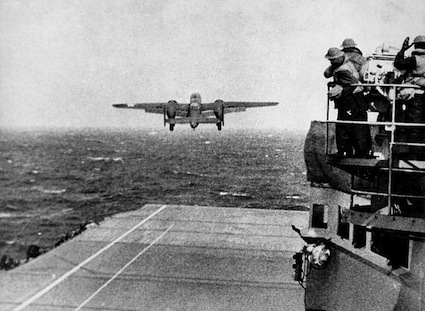

Twin-engine aircraft, twins, seem to fascinate many RC modelers. Maybe it is an historical image we carry in our minds. We can picture a Doolittle B-25 lifting from the deck of the Hornet or the sleek design of a de Havilland DH-88 Comet.

Unfortunately, all too often our fantasy, when put into practice with a model twin, doesn't work out all that well.
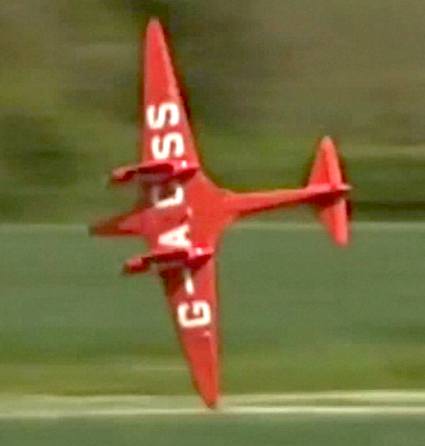
Are Twins Really More Difficult to Fly?
On any given day at our flying field, who do you see flying a twin? It might be Keith Shaw (DH-88 Comet "Black Magic", Aero Commander Shrike or modified TwinStart so seaplane), Jim Young (DH-88 Comet or Gloster Meteor), Denny Sumner (Sportwin, Super Sportwin or HOB Commander/Shrike), Rick Sawicki (Banana Hobby P-38), Paul Sockow (Multiplex TwinStar II) or Jim Senia (Dynam Grand Cruiser Twin). There are other folks in our club with twins, but you just don’t see them flying them day in and day out.
What do all of these pilots and all of their planes have in common? They all use electric power systems in their planes. They have removed one of the big headaches of flying a twin by using a reliable power system.
There are four factors that greatly influence the success of any twin.
The first factor is the wing cube loading. A review article, "Cubic Wing Loading (CWL)" is found at www.theampeer.org/midwest/articles/cwl.html.
More information on Wing Cube Loading (WCL) may be found in the Site Table of Contents at the EFO Web site. Look for the heading Cubic Wing Loading.
I have found seven WCL levels.
Level 1 ? - 2.99 oz./cu.ft. flies like indoor
Level 2 3 - 4.99 oz./cu.ft. flies like backyard flier
Level 3 5 - 6.99 oz./cu.ft. flies like park flier
Level 4 7 - 9.99 oz./cu.ft. flies like trainer/sport
Level 5 10 - 12.99 oz./cu.ft. flies like adv. sport
Level 6 13 - 16.99 oz./cu.ft. flies sporty for an Expert
Level 7 17+ oz./cu.ft. requires expert finesse on the sticks and a complete understanding of the things not to do with the particular aircraft!
The majority of planes flown by the whole RC Community, electric/glow/gasoline, are WCL Level 4 planes. On any given day at an RC flying field you see more planes that belong in Level 4 than any other type.
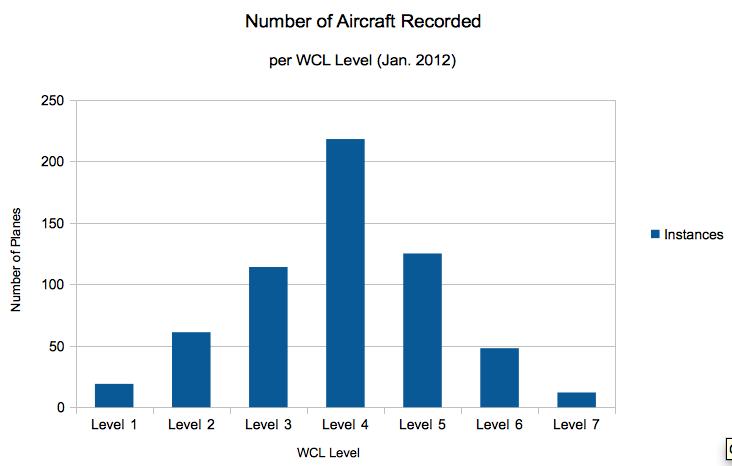
Over the years I have logged data for over 600 individual aircraft. The data comes from reviews in magazines, online and personal experience. The data in the graph demonstrates that Level 4, 7 oz./cu.ft. through 9.9 oz./cu.ft., is the dominate type of RC aircraft. Well over 1/3 (218) of the logged planes are of this type.
The data, in Excel workbook form, is at www.theampeer.org/new-power-theory/metricnewtheory.xls
The majority of RC twins are found in WCL Levels 5, 6 and 7!
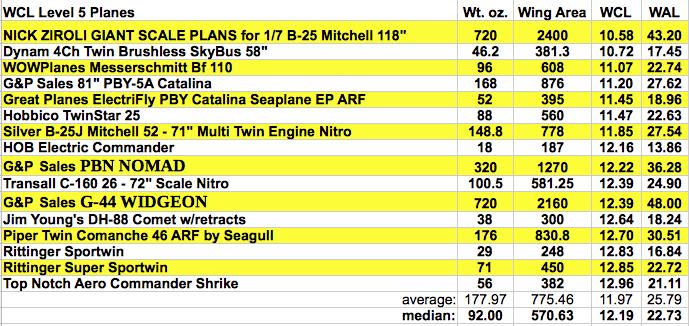
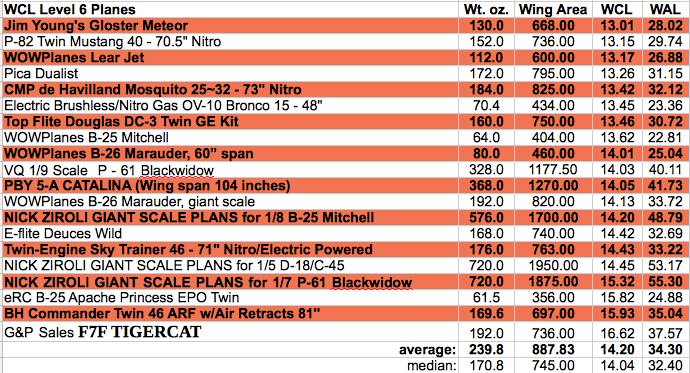
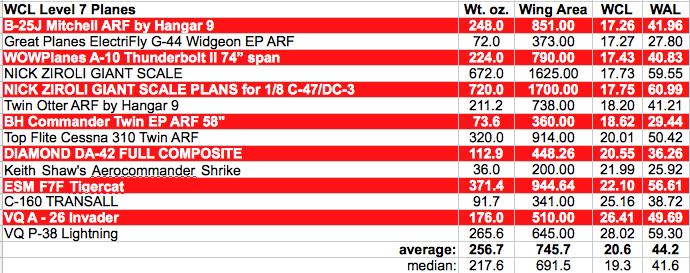
A second factor that influences the success of a twin is speed. There is no, or very, very little data available on actual flight speeds for the majority of RC models.
In his article, "Electric Twins", by Keith Shaw, Model Airplane News, Dec. 1991, he notes "Actual flight speed for streamlined twins will be at the prop (pitch) speed or a little faster. Twins with higher drag such as large radial cowls or large cross-section fuselages might only be 85 to 90 percent of the prop (pitch) speed."
I have calculated the median pitch speed and average pitch speed for the 600 models based on their stated prop pitch and RPM.
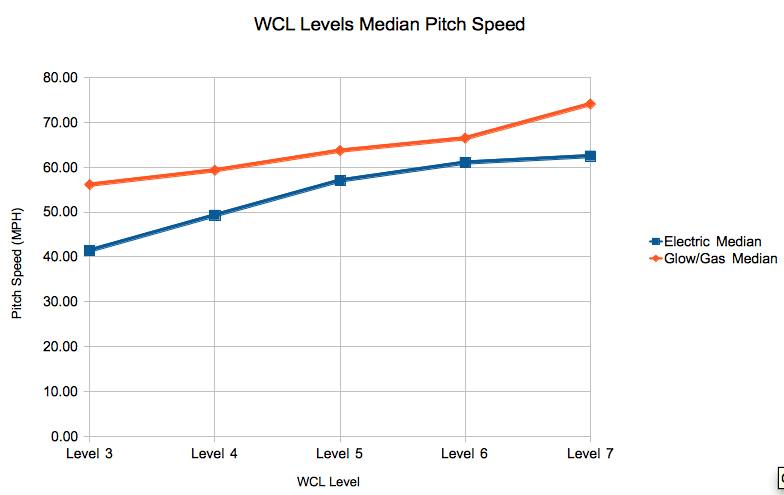
There are no glow or gasoline powered WCL Level 1 planes and only 3 WCL Level 2 glow planes in my collected data. The graph shows the median pitch speeds for Level 3 through Level 7. Median indicates that half the planes are faster and half slower, but it gives a reference point.
The trend is quite clear. As the wing cube loading (WCL) level increases, the median pitch speed also increases. Most of the planes at the flying field, WCL Level 4, are flying at a median pitch speed of between 50 mph and 60 mph. Most twins are found in levels 5 through 7 where the median pitch speeds are between 58 mph and 75 mph.
The third factor is wing planform and overall design. As demonstrated by the photo of the crashing DH-88 near the beginning of the article, a highly double-tapered wing planform can sometimes provide unwanted consequences, even worse than when used on a single engine aircraft.
There is little help online regarding the selection and tips for a twin project. There are two articles online that provide some tips for glow powered planes. They are "So You Want To Fly Twin Engine RC Planes" author unknown and "twin tips - 1/21/2012" by Ed Moorman.
Both articles stress the importance of having a reliable power system, which using an electric power system provides.
Both authors are vague about wing loading.
Author Fly Twin, "Wing loading is higher than standard airplanes and so landing speeds are faster... Do not try to slow down and risk a stall..."
Ed Moorman, "5. Twins are heavy... and have a higher wing loading.
6. Twins land faster. Since they are heavier, a twin tends to land a little bit faster..."
For the 'typical' sport pilot, it is a good idea to select a plane with a lower WCL than a typical twin.
As with most things in life, there are exceptions. Twins are no different.

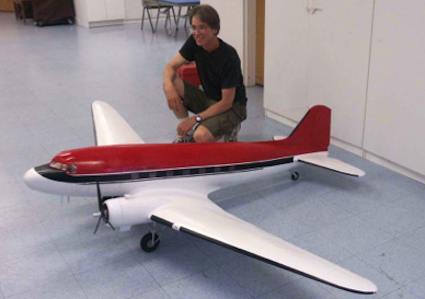
According to Model Aviation, Feb. 2012, page 97, Jeff Weisend's DC-3 has an astoundingly low WCL of 3.74 oz./cu.ft. and flies like a backyard flier. With a wing area of approximately 1420 sq.in. and a weight of only 7.25 lb./116 oz. it is truly amazing. This is not something a typical modeler would be able to create, not that they might want to.
As noted in the text, "... the model looks better in the air from a distance, as one can see the effect on the plane of the slightest breath of wind."
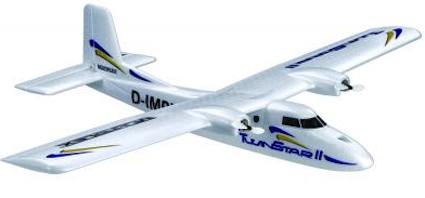
The Multiplex TwinStar II is a good place to start a 'twin experience'. It has the WCL of a park flier, although it is too heavy to fit the AMA definition of a Park Flyer, but it flies like one. Good choice on that one Paul!
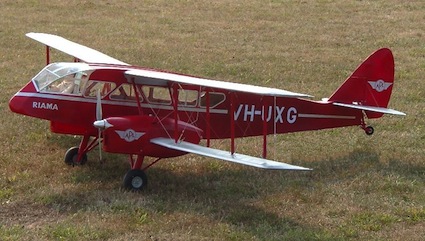
A biplane twin like the de Havilland DH-84 Dragon-2 or the DH-89 Rapide are good choices.
The biplane configuration lowers the WCL. With no retracts, the weight is kept down and construction kept simple.
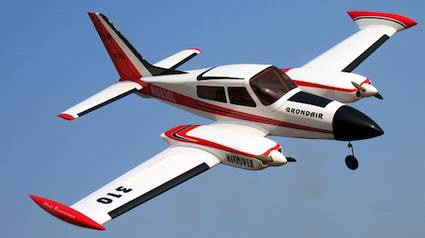
The New 310-Scale 90 - 92.5" Twin Engine Nitro Power Radio Controlled Plane ARF is a glow powered plane but has what appears to be an extremely low WCL, based on their specifications.
None of the data that I've collected on RC planes ranging from 1000 sq.in. and up suggests the advertised flying weight of 11 lb. is possible.
Dick Pettit Associate Editor of R/C REPORT Magazine reviewed this plane.
His weighed 16.5 lb. WCL at 16.5 lb. is 9.5 oz./cu.ft. Although powering this plane would be very expensive, it could make a good first twin electric.
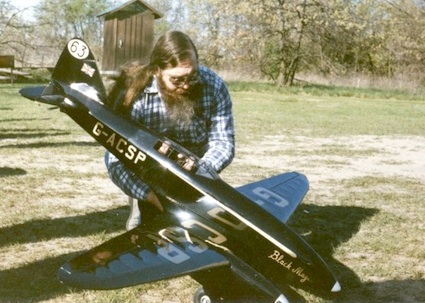
A twin the size and weight of Keith Shaw's "Black Magic" is best left to the master. The empty fuselage weighs just 4 oz. Can you do that?
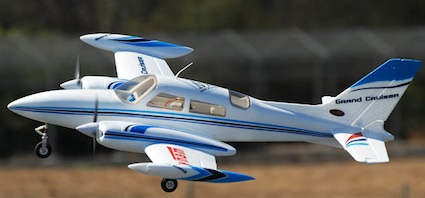
The Dynam Grand Cruiser Twin flies like a sport plane. Anyone who is comfortable flying sport planes should be successful with it. Good choice Jim!
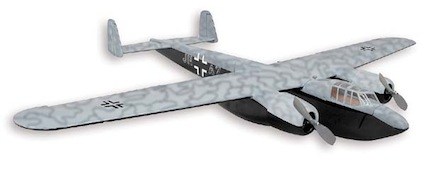
The SIG Do 217 provides one more clue to producing a successful twin. It has a WCL on the high side of sport or low side of advanced sport, which indicates that folks who generally fly planes in the Level 4 category shouldn't have a problem flying it. The designer used several "tricks" to make this a twin that can be flown by the 'masses'.
One reason that it flies like a sport plane is because the designer enlarged the wing. Using the fuselage length to scale the model from the full-size plane, it is about 1/19-scale. At 1/19 scale the wing area should be 242 sq.in. With a 242 sq.in. wing the model would have a WCL expected of a typical twin, ~16 oz./cu.ft.
Using the wingspan, the plane scales to about 1/16-scale. At 1/16 scale the wing area would be about 349 sq.in. The given wing area for the model is 335 sq.in. By enlarging the wing the designer moved the WCL to just about 10 oz./cu.ft, which makes it a bit easier to fly for most RC pilots.
Also, by having the rudder and the landing gear as "optional", the designer cut down on the ready to fly (RTF) weight.
The fourth factor is pilot experience.
To learn what your pilot experience is, inventory the planes that you fly day in and day out and calculate their wing cube loadings.
WCL = RTF weight in ounces / ((wing area/144)^1.5)
The highest WCL of your regularly flown fleet indicates the level that you are comfortable flying at.
For me, it would be my Bill Griggs Rocket and my self-designed E-250. The Rocket has a CWL of 16 oz./cu.ft and the Lightening (yes, I meant Lightening not Lightning) E-250 14.9 oz./cu.ft. Both are CWL Level 6 types. Personally, I would choose a twin like those listed in the Level 5 table to start with and then move up through each progressive level to reach my 'ultimate scale twin'.
Whenever possible, follow the recommendation of the manufacture, designer, supplier or what was used on similar types and sizes found in the modeling press or online.
If that is not possible, selecting a power system for a twin propeller type plane depends on ground and fuselage clearance. The largest diameter prop should be chosen that provides sufficient clearances.
A chart like the one found at www.coastalplanes.com/tools/propchart.htm is useful for selecting the appropriate size glow or gasoline engines based on the usable largest diameter prop.
The table at that Web site also provides typical RPM ranges the type of engine. With the known RPM, the pitch is selected to allow the pitch speed to be at least the median for the WCL level of the twin.
There are many ways to select an electric power system, if one is not recommended. If you are unsure of how to do that, please drop me an email, and we will discuss it here in the Ampeer, or give me a call. Also, see the February 2012 Ampeer. I describe how to select a power system for an 80" PBY and that information may be applied to other twins as well. Also, the first article in this issue should help as well.
1.) For your first twin, choose a subject with a WCL similar to or just below the WCL level you are comfortable flying at now. There is a lot to learn about twin engine operation. Learning to fly with a WCL greater than you are comfortable with should not be one of them.
2.) Before flying your twin, put in a lot of practice time on your highest WCL plane(s) and consider acquiring a single-engine type with an even higher WCL or even adding weight at the CG to a plane you already have.
3.) If you 'roll your own' designs, consider going through a series of steps to get to your ultimate twin. Remember that the more options* that are added to the airframe the heavier it becomes with a resulting higher WCL and the more difficult it becomes to fly.
(options* - anything that is added to the airframe that has nothing to do with controlling the airplane. Keep the Sig DO-217 design in mind; start with only the necessary flight controls, keep the landing gear simple, if used, and/or fudge the wing area of the early prototype.)
Information about wiring brushless twins:
Video:
www.youtube.com/watch?v=aADN7iCx9E4
Web Links:
www.electricflyermagazine.com/page17.html
www.electricflyermagazine.com/page16.html
www.electricflyermagazine.com/page18.html
Magazine:
November 2004, Fly RC, Tom Hunt's article on multi-motor brushless power systems.